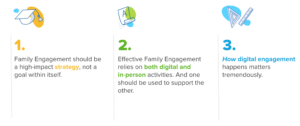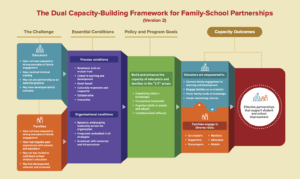Written by TalkingPoints
Educators are united by a single mission: to ensure every student leaves K-12 prepared for the future.
It seems simple, right?
Yet, everyday challenges often stand in the way of making that goal a “simple” reality. From chronic absenteeism to staffing challenges to culture and language differences, the barriers are plenty and can stop progress in its tracks. Addressing challenges one at a time isn’t sustainable or scalable. That’s where a strategic approach to family engagement comes in.
Research shows that meaningful family engagement is a powerful tool that profoundly impacts student success. Yet in many districts, family engagement is siloed into one department. Transforming family engagement in schools into a high-impact strategy is a much-needed mindset shift for improving student outcomes.
Want to see these strategies put into action? Watch the full webinar here.
3 key mindset shifts
Three mindset shifts put educators in a position to create true change through family engagement.

- Break traditional barriers by reframing family engagement—not as a goal, but as a high-impact strategy. It can no longer be seen as a warm and fuzzy “nice to have”, but should be seen as a necessity. This means supporting family engagement with the proper tools, educating staff on best practices, and ensuring engagement for all families across the district.
- Rely on both digital and in-person activities for engagement. They should work in tandem and support each other. Schools can promote in-person events through digital outreach before, after, and even while they take place. Digital connections can augment the efficacy of events, as we note here, with gathering info before to support a better event and following up to ensure benefits are fully realized. Look for opportunities to marry the two tactics together for optimal results.
- Be mindful of how digital engagement happens. It can be easy to fall into the trap of updating families across every communication channel, regardless of the message. This strategy will cause information overload and ultimately lead to families tuning out any updates. Instead, a strong two-way communication approach is key. Don’t just push information to families, invite participation. Ask for replies, encourage involvement, and include surveys to deepen engagement and build trust.
Put the shifts into practice
Once these mindset shifts are embraced, the next step is to take action. Get started using these three research-based approaches that are as sustainable as they are impactful.
- Build trust with families. Prioritize two-way communication by removing common language, access, and availability barriers. Messages should always consider diverse family backgrounds, have best-in-class translation built for K-12, and include personalization when possible. Adopt communication channels that are easy to access, such as text messages, to ensure all families stay connected.
- Be intentional with every touchpoint. Provide a positive, clear purpose in your message so families understand the importance of your message.
- Lead with why: Don’t just announce an event, explain how their involvement makes an impact. Show the value in their participation.
- Be mindful of wording. Positively framed messages will put relationships with families on the fast track to growth.
- Ask for action. Always include a call to action in your messages. Families are much more likely to take next steps if you clearly articulate what those steps are.
- Find the balance. Unfortunately, there isn’t a perfect equation for the exact number of messages to send. Too much communication can cause “spam fatigue,” and too little communication can leave families in the dark. Review engagement data to understand what your families need. If that data isn’t available, ask! A quick survey can reveal the best channels and frequency preferences.
Want to see these strategies put into action? Watch the full webinar here.
Watch the impact happen
Transforming family engagement from a check in a box to a high-impact strategy will bring measurable outcomes that can be seen across the district.

Students with families who are engaged with schools often see improved attendance, stronger academic performance, and overall better well-being. They have balanced support at home and school, leading to a more well-rounded, empowered educational experience.
Classrooms feel the impacts of stronger family engagement by having a more responsive learning culture. Teachers experience improved class-wide behavior and responsive support from families.
Schools experience deeper trust and a more positive environment. Strong family engagement contributes to higher teacher retention and fewer learning barriers, thanks to families playing an active role in the learning process.
District-level gains lead to crucial broader impacts. Key student improvements include academic success, post-secondary readiness, and better student behavior, which can lead to improvement in systemic indicators such as increases in enrollment and post-secondary success. Also, support from the community can grow as trust among families begins to permeate across the local level.
Accelerate change with technology
Supporting the mindset shifts with technology can help accelerate positive engagement momentum. TalkingPoints’ Universal Family Engagement platform is accessible to all families and emphasizes creating a space for positive two-way communication. With built-in best practices, two-way communication capabilities and barrier-free translation, TalkingPoints empowers educators, staff and families to work together to improve student outcomes.
Learn more about how TalkingPoints can support these mindset shifts and grow your family engagement strategy.



